Raft Foundation vs Pile Foundation – Confused between Raft Foundation and Pile Foundation? Discover the key differences, uses, advantages, and limitations of both foundation types to choose the best one for your construction needs.
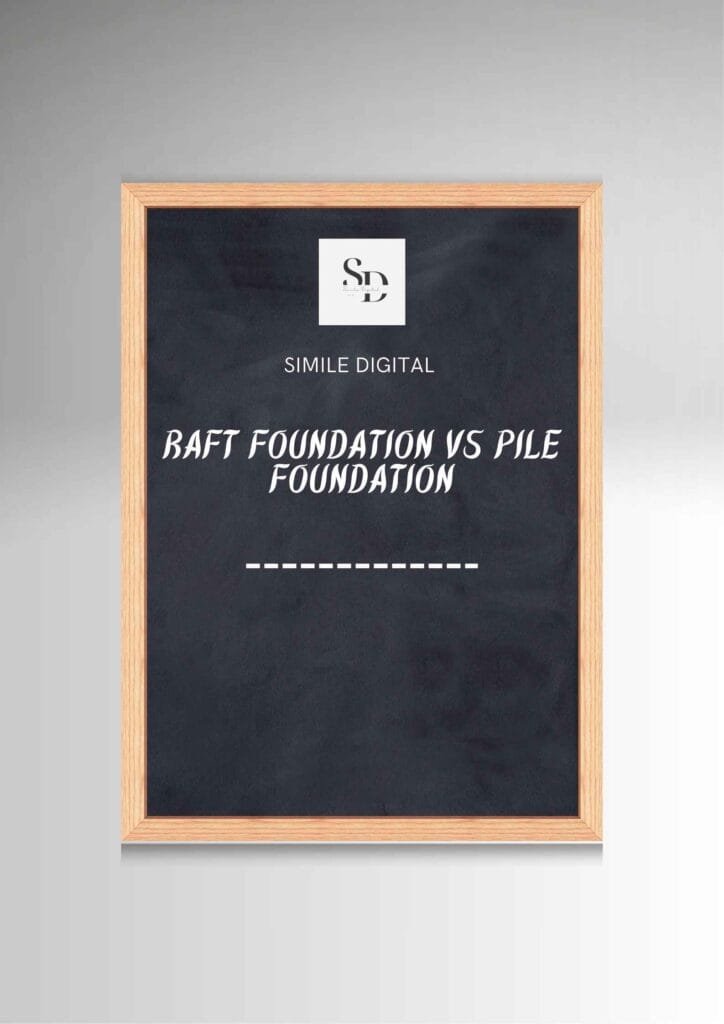
Table of Contents
Introduction
Before we dive into raft and pile foundations, let’s take a step back and understand the basics.
A foundation is the part of any structure that transfers the load of the building to the ground. It ensures the stability, safety, and longevity of a structure. Without a good foundation, even the most beautifully designed building can face cracks, tilting, or even collapse.
Now, foundations are mainly divided into two broad categories:
- Shallow Foundations
- Deep Foundations
Each of these categories has different types of foundations based on how they distribute load and how deep they go into the earth.
Types of Shallow Foundations:
- Isolated Footing – Used for single columns.
- Combined Footing – Supports two or more columns.
- Strip Footing – Used under load-bearing walls.
- Mat or Raft Foundation – Spreads the load across a large area, especially useful for weak soils.
Types of Deep Foundations:
- Pile Foundation – Long, slender columns driven deep into the ground.
- Pier Foundation – Cylindrical columns used when firm strata is not too deep.
- Caisson Foundation – Hollow structures sunk into the ground, often used in waterlogged areas.
Now that you know the basic types, let’s focus on Raft Foundation and Pile Foundation, two of the most widely used methods—especially in modern construction projects where soil conditions and load demands vary greatly.
What is a Raft Foundation?
A Raft Foundation, also known as a Mat Foundation, is a large concrete slab that spreads across the entire area of a structure, supporting walls and columns together. Imagine placing your entire building on a big flat tray—that’s pretty much how a raft foundation works. It “floats” on the soil like a raft on water, distributing the load evenly.
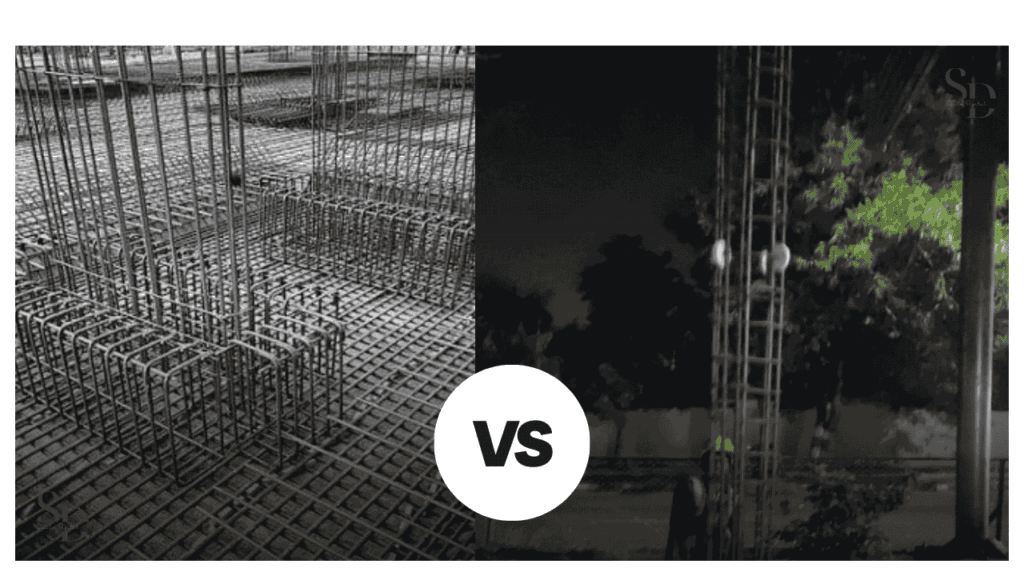
Key Properties of Raft Foundation
- Large Surface Area: It covers the full footprint of the building, spreading loads over a wide area.
- Uniform Load Distribution: Because the entire base is connected, loads from walls and columns are evenly distributed, reducing chances of uneven settlement.
- Good for Weak Soils: Especially helpful when the topsoil has a low bearing capacity. The load is spread out instead of being concentrated at specific points.
- Minimizes Differential Settlement: Since the whole structure rests on a single slab, movement is more uniform—even if the soil behaves differently in different spots.
- Integrated Design: Raft foundations often include beams, slabs, and even reinforcement to handle bending and shear forces effectively.
Where Should Raft Foundation Be Used?
- Low Bearing Capacity Soil: If the ground isn’t strong enough to support individual footings, a raft foundation helps by spreading the load.
- Closely Spaced Columns: When columns are too close to each other, individual footings might overlap. A raft eliminates that issue.
- Basement Construction: Rafts work well in structures that have basements, because the raft can act as the base slab of the basement.
- Waterlogged Areas: In areas with high groundwater levels, rafts resist uplift pressure better than isolated footings.
- Heavy Structural Loads: Industrial buildings, commercial complexes, and multi-storey buildings often prefer raft foundations for better load handling.
Types of Raft Foundations
- Flat Plate Raft – Simple, flat concrete slab for lighter structures.
- Plate with Beams Raft – A flat slab reinforced with beams between columns.
- Cellular Raft or Box Raft – Consists of two-way beams creating a cellular structure; used for very heavy loads.
- Piled Raft Foundation – A hybrid where piles are added under the raft for extra support.
Advantages of Raft Foundation
- Economical for poor soil when compared to multiple footings.
- Reduces structural stress and cracks.
- Quick to construct, especially when compared to deep foundations.
- Helps in waterproofing in basement levels.
Limitations of Raft Foundation
- Not suitable for sloped sites.
- Requires large quantities of concrete and steel.
- Needs careful design to handle bending and shear.
- Can be affected by high water tables unless properly treated.
What is a Pile Foundation?
A Pile Foundation is a type of deep foundation where long, slender columns (called piles) are driven or drilled deep into the ground to transfer the load of the structure to stronger soil or rock layers far below the surface. Think of it as pushing a long post into the ground to support a structure, where the post reaches deeper layers of soil that can handle more weight.
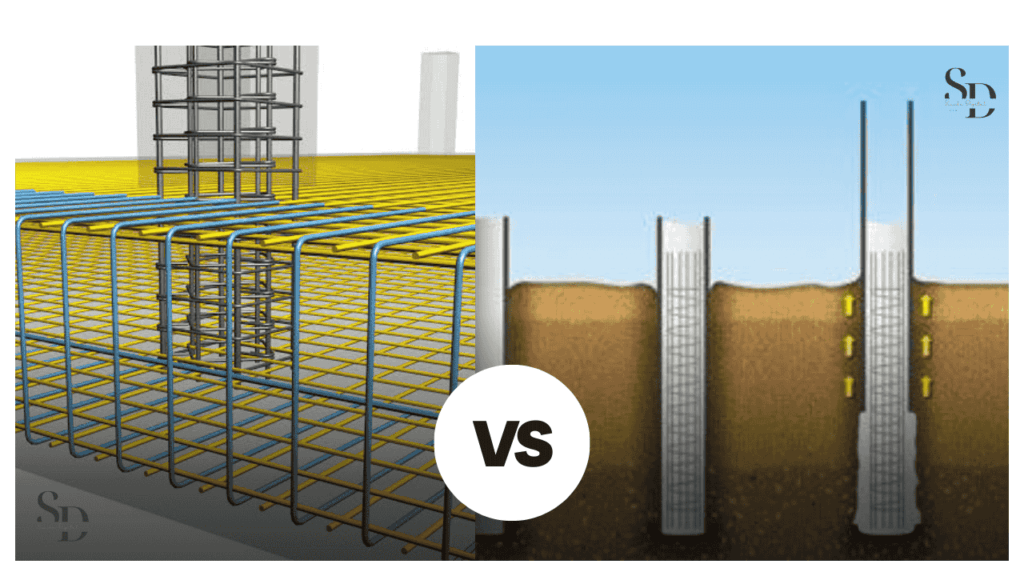
Pile foundations are used when the surface soil is too weak or loose to support the weight of a building or structure. By extending the load-bearing capacity to deeper and more stable layers, pile foundations ensure the safety and stability of the structure above.
Key Properties of Pile Foundation
- Deep Load Transfer: Piles transfer the load from the structure through weak surface soil to the stronger, deeper soil or bedrock, providing solid support.
- Variety of Pile Types: There are different kinds of piles, such as end-bearing piles (which rest on strong bedrock or deeper strata) and friction piles (which rely on the friction between the pile surface and the surrounding soil).
- Length and Diameter: Piles come in various lengths and diameters, depending on the soil conditions and load requirements. They can be much deeper than shallow foundations, making them ideal for large buildings.
- Resistance to Lateral Forces: Piles can resist lateral (sideways) forces, making them effective in areas with high winds, earthquakes, or where there’s a need to withstand horizontal forces.
- Versatile in Construction: Piles can be used in a variety of construction, from residential buildings to bridges and even offshore structures. They’re especially useful in areas with challenging ground conditions.
Where Should Pile Foundation Be Used?
- Weak Surface Soils: When the surface soil is not strong enough to bear heavy loads, pile foundations reach deep into the earth to transfer loads to stronger layers.
- High-Rise Buildings: Pile foundations are common in tall buildings, where large loads need to be supported over a small footprint. They can go as deep as necessary to ensure stability.
- Bridges and Marine Structures: Piles are often used to support bridges, piers, and other structures in water or near rivers, as they can be anchored into solid soil or rock below the water table.
- Sites with High Water Tables: Pile foundations can penetrate through soft, saturated layers and are highly effective where groundwater levels are high or where soil is prone to shifting.
- Uneven Terrain: On uneven or sloped land, piles can be driven at different depths to ensure the structure is supported uniformly across the entire footprint.
Types of Pile Foundations
- End-Bearing Piles: These piles transfer the load to a solid, hard layer of rock or soil beneath the surface. The load is carried at the tip (or end) of the pile.
- Friction Piles: Instead of resting on a solid layer, these piles rely on friction between the surface of the pile and the surrounding soil to transfer the load.
- Cased Piles: Made of steel or concrete casing, these piles are driven or drilled into the ground, providing both strength and protection in loose or sandy soils.
- Bored Piles: These piles are drilled into the ground, and concrete is poured into the hole, providing a strong foundation for large structures.
- Helical Piles (Screw Piles): These are screw-shaped piles that are twisted into the ground, ideal for applications where minimal vibration and noise are required, like in residential areas.
Advantages of Pile Foundation
- Ideal for Weak Soil: Pile foundations work wonders where surface soil is too weak, shifting, or waterlogged.
- Supports Heavy Loads: Perfect for structures like high-rises, bridges, and industrial buildings.
- Resistant to Movement: They resist settlement, making them suitable for projects on uneven or unstable terrain.
- Minimal Ground Disturbance: When drilled or screwed in place, pile foundations cause less disruption to the surrounding area.
- Versatility: Can be used in various environments, including marine and offshore projects.
Limitations of Pile Foundation
- High Construction Cost: Installing piles can be expensive due to the equipment and labor involved.
- Time-Consuming: The process of driving or drilling piles deep into the ground can be time-consuming.
- Noise and Vibration: Pile installation can cause noise and vibration, which can be disruptive, especially in urban areas.
- Limited to Certain Soil Types: Pile foundations may not be effective in soils that are too dense or too hard to penetrate.
Comparison between Raft and Pile Foundation
1. Soil Bearing Capacity:
- Raft Foundation: This foundation type is generally used when the soil has moderate to low bearing capacity but can still distribute the loads evenly across a large area. It works well in cases where the surface soil is not strong enough for shallow foundations but can accommodate a distributed load. Rafts can also be designed to handle weaker soils by increasing the surface area over which the load is spread.
- Pile Foundation: Pile foundations are often employed when the surface soil is weak and lacks sufficient bearing capacity. In these cases, piles are driven deep into the ground to reach stronger, more stable soil or bedrock. The soil at greater depths must have the ability to bear heavy loads.
2. Cost Consideration:
- Raft Foundation: Generally, raft foundations are cost-effective for large areas, especially where the load-bearing capacity is moderately low. The cost primarily depends on the amount of concrete and reinforcement required, but overall, it is cheaper than pile foundations for sites with relatively uniform, weak soils.
- Pile Foundation: Pile foundations are typically more expensive due to the complexity of installation, specialized equipment, and deeper excavation. The need for pile driving machinery and longer construction times adds to the cost. In sites where piles must penetrate deep into the soil or rock, the cost increases substantially.
3. Installation and Construction Time:
- Raft Foundation: One of the advantages of a raft foundation is its quick installation. It involves creating a large concrete slab that covers the footprint of the building. This process is relatively simple and does not require specialized equipment beyond the basic construction machinery.
- Pile Foundation: Installing pile foundations is time-consuming and requires more specialized machinery, such as pile drivers or drilling rigs. The process can take longer, especially when piles need to be driven or drilled to substantial depths to reach stable soil.
4. Suitability for High-rise Structures:
- Raft Foundation: Raft foundations are suitable for low to medium-rise buildings and structures that do not exert extremely high loads. They are effective in distributing weight across a large area, but they may not be ideal for high-rise buildings or where deep stabilization is needed.
- Pile Foundation: Pile foundations are often preferred for high-rise buildings and other heavy structures because they can transfer the building’s load to deeper, more stable soil layers. These foundations are essential for very tall or massive structures where significant load-bearing capacity is required.
5. Load Distribution:
- Raft Foundation: A raft foundation distributes the building’s load over a wide, flat surface, which helps to prevent uneven settlement of the structure. It’s designed to work as a monolithic slab that absorbs and evenly distributes the pressure across the entire area, which is ideal when dealing with uneven or weak soils.
- Pile Foundation: Pile foundations concentrate the load onto individual piles, which are driven deep into the ground to bear the load on stronger layers beneath the surface. This can lead to better performance when the surface soil is unstable but requires more detailed analysis to ensure uniform load distribution across all piles.
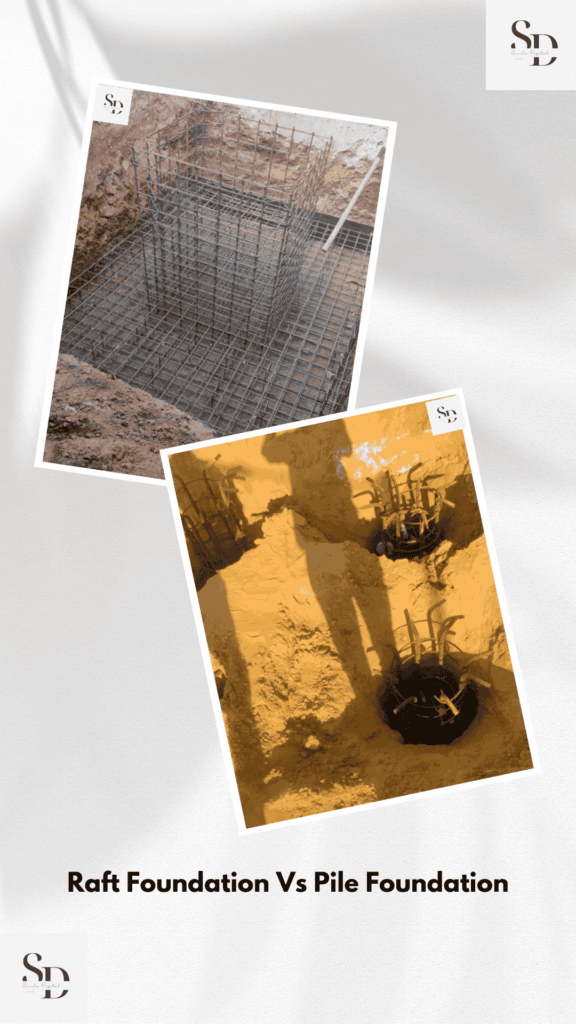
6. Application to Soil Conditions:
- Raft Foundation: Raft foundations are best suited for sites with uniform but weak soil. They perform well in areas where the soil is homogeneous and where the risk of differential settlement is low. However, they are not as effective in areas with large variations in soil types at different depths.
- Pile Foundation: Pile foundations excel in heterogeneous soil conditions, such as sites with varying depths of weak soil or areas prone to shifting soil layers. Piles can penetrate deep into the ground, ensuring stability regardless of the superficial soil properties.
7. Flexibility and Versatility:
- Raft Foundation: Rafts provide more flexibility in terms of design, especially for buildings with large footprints. They are more adaptable in handling varying load distributions across the site, making them suitable for sprawling commercial complexes, large apartment buildings, and industrial structures.
- Pile Foundation: Pile foundations are more rigid and require precise planning and design. They are effective for specific load-bearing conditions and may not offer as much flexibility for projects with irregular layouts or large structures that require varied load distribution.
8. Site Accessibility and Construction Constraints:
- Raft Foundation: Raft foundations are relatively simple to install and are suited for sites that are easily accessible. Construction is straightforward, and no specialized equipment is required beyond basic formwork and concrete pouring.
- Pile Foundation: Pile foundations are ideal for sites with restricted access or areas that are difficult to excavate, such as marshy land, coastal areas, or urban locations where underground utilities may complicate excavation. However, the installation of piles in such conditions can require more sophisticated techniques and machinery.
9. Settlement and Maintenance:
- Raft Foundation: Raft foundations are designed to minimize differential settlement by evenly distributing the load. However, in cases where the soil conditions are not ideal, they might still experience some settlement over time, leading to structural issues that may require post-construction monitoring and maintenance.
- Pile Foundation: Pile foundations are less susceptible to settlement, as they rely on stable, deep soil layers for support. Properly designed pile foundations experience minimal movement over time, making them more durable and reducing the need for maintenance.
10. Environmental Impact:
- Raft Foundation: Raft foundations tend to have a lower environmental impact compared to piles because they involve less excavation and fewer raw materials. The concrete used in raft foundations is often recycled, and less energy is consumed during the construction process.
- Pile Foundation: Pile foundations have a higher environmental impact due to the extensive use of materials (steel, concrete, etc.) and the energy-intensive processes involved in driving or drilling piles into the ground. The equipment used also generates significant noise and vibrations, especially in urban or environmentally sensitive areas.
Foundation Calculation
Raft Foundation Calculation
The calculation of a Raft Foundation involves determining the total load to be supported and ensuring that the foundation can distribute that load evenly over the area.
1. Load Calculation:
- Dead Load: This is the permanent load from the building’s structural components such as walls, beams, columns, floors, and roofs.
- Live Load: This is the variable load that changes depending on occupancy, furniture, equipment, etc.
- Additional Loads: Wind, seismic loads, or any external loads from machinery or equipment on the building.
2. Area of the Raft:
- The area for the raft foundation is calculated by dividing the total load by the allowable bearing capacity of the soil. The formula is:
- A(raft) = (Total Load) / Allowable Bearing Capacity
- Total Load is the sum of all the loads (dead + live + additional).
- Allowable Bearing Capacity is the maximum load the soil can safely support per unit area.
3. Thickness of the Raft:
- The thickness of the raft depends on the total load, soil conditions, and the type of raft being used (e.g., flat slab, slab with beams).
- A basic method involves considering bending strength and shear capacity of the raft material, which is typically designed using structural engineering principles.
4. Reinforcement Design:
- The raft is reinforced with steel bars to ensure strength. The amount and type of reinforcement depend on the load, thickness, and material properties of the concrete.
- This is determined using design codes like the IS 3370 for concrete or relevant structural codes for reinforcement.
5. Settlement Calculation:
- You also need to calculate the settlement of the raft foundation to ensure that the load is distributed evenly and that the foundation does not sink unevenly. This is particularly important for weak or compressible soils.
- Settlement is calculated based on the compressibility of the soil and the applied load.
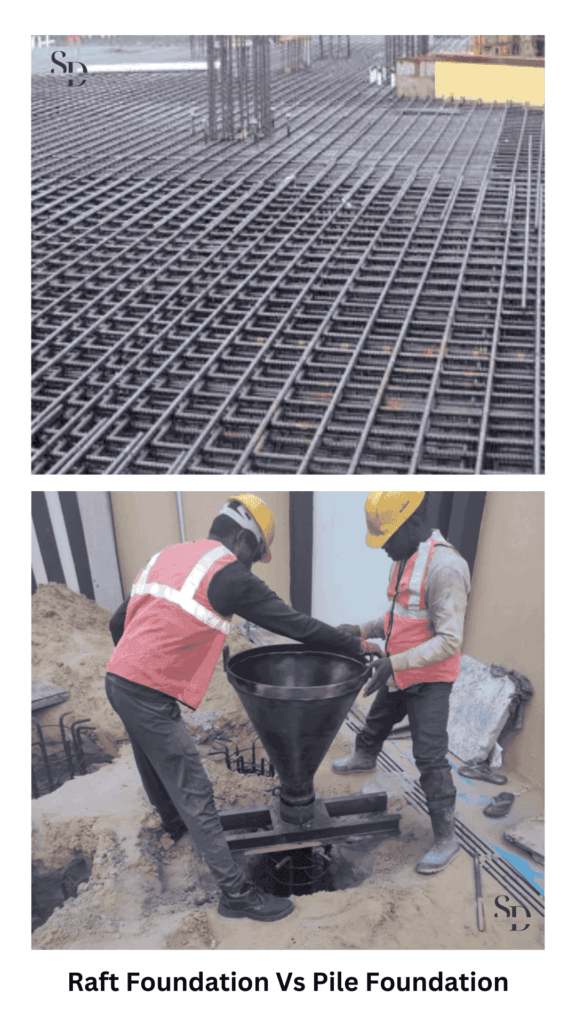
Pile Foundation Calculation
The calculation for a Pile Foundation is more complex because it involves considering the type of piles (end-bearing, friction), their length, and the soil strata.
1. Load Calculation:
- Just like the raft foundation, the total load needs to be calculated first (dead, live, and additional loads).
2. Selection of Pile Type:
- Depending on the soil conditions, you will choose between different pile types:
- End-Bearing Piles: These transfer the load directly to a solid rock or deeper soil layer.
- Friction Piles: These rely on the friction between the pile and the surrounding soil to transfer the load.
3. Pile Capacity Calculation:
- For end-bearing piles, the load-carrying capacity is calculated using:
- Q_(pile) = A_{pile} * sigma_{b}
- A_{pile} is the cross-sectional area of the pile.
- sigma_{b} is the bearing capacity of the soil at the pile tip (bedrock or deeper solid soil).
- For friction piles, the load-carrying capacity is calculated based on the skin friction between the pile and the surrounding soil. This is calculated as:
- Q_{pile} = sum (f_s * A_pile)
- f_s is the skin friction at different depths.
- A_pile is the surface area of the pile along its length.
4. Number of Piles:
- The total load needs to be distributed among all piles. The number of piles is calculated by dividing the total load by the load capacity of a single pile:
- N_piles = (Total Load) / (Capacity of One Pile)
5. Pile Length:
- The length of the pile is determined by the depth at which strong, stable soil or bedrock is found. The length of piles can be calculated based on the type of soil strata and the load the pile is intended to carry.
6. Settlement and Group Action:
- For pile foundations, settlement analysis is crucial. Even though individual piles might not settle significantly, the combined effect of multiple piles must be considered.
- The settlement of the pile group is calculated considering group efficiency, which depends on how closely spaced the piles are and the interaction between them.
7. Pile Cap Design:
- The pile cap is the concrete slab at the top of the piles, connecting them and transferring the load from the structure to the piles. The pile cap is designed based on the total load from the structure and the number of piles. Reinforcement is added according to structural design requirements.
How to Choose Between Raft Foundation and Pile Foundation?
The decision between Raft Foundation and Pile Foundation depends on several factors related to the site conditions, the type of structure, and the expected loads.
1. Soil Bearing Capacity
- Raft Foundation: Suitable when the soil has a moderate to low bearing capacity but can still distribute loads over a large area. It works well when the soil is not too weak or soft, and the load is spread evenly.
- Pile Foundation: Ideal when the surface soil has a very low bearing capacity or when there are significant variations in the soil strength at different depths. It’s used when the soil near the surface cannot bear the loads effectively and the load needs to be transferred to deeper, more stable strata.
2. Type of Structure
- Raft Foundation: Often chosen for large, heavy buildings or structures like high-rise buildings, residential complexes, and industrial plants, where the loads are spread over a wide area.
- Pile Foundation: More suitable for high-rise buildings, bridges, and structures in areas with poor soil conditions or where foundations need to go deep into the earth, such as in marine environments or sites with soft clay.
3. Cost Considerations
- Raft Foundation: Generally more cost-effective compared to pile foundations, especially when the site does not require deep excavation and piling.
- Pile Foundation: More expensive due to the need for specialized machinery and deeper installation, but necessary when soil conditions are unsuitable for shallow foundations.
4. Construction Time
- Raft Foundation: Installation tends to be quicker as it requires less machinery and is more straightforward to construct.
- Pile Foundation: Installation is more time-consuming due to the need for drilling, pile driving, or other specialized techniques.
5. Site Accessibility
- Raft Foundation: Suitable for sites that are easily accessible and where the foundation can be spread over a large area.
- Pile Foundation: Works well on sites that may have restricted access or when there are other challenging factors, such as waterlogged areas or marshy land.
6. Load Distribution
- Raft Foundation: Distributes the load of the building across a wide surface, reducing the potential for differential settlement.
- Pile Foundation: Transfers the load to deeper, stronger layers of soil, making it ideal for areas with varying soil conditions and where the surface soil may not provide adequate support.
Minimum Soil Bearing Capacity for Raft and Pile Foundations
Raft Foundation
- Minimum Bearing Capacity: Typically, raft foundations are used for soils with a bearing capacity ranging from 100 kN/m² to 250 kN/m². If the soil’s bearing capacity is below this, the raft may be inefficient as it will not distribute the load effectively.
- In areas with very low bearing capacity, additional soil improvement techniques (like soil stabilization) may be needed to increase the soil’s strength.
Pile Foundation
- Minimum Bearing Capacity: Pile foundations are often used when the soil’s bearing capacity is less than 100 kN/m², or when the surface soil is too weak to support the structure. Piles are driven into deeper soil or rock layers that have much higher bearing capacities, often exceeding 200 kN/m² or more, depending on the depth of the pile and the strength of the deeper layers.
- Pile foundations are designed to penetrate deeper and rely on the bearing capacity of the deeper strata rather than the surface soil. For these types of foundations, the soil beneath the surface must have a sufficient bearing capacity to support the structure after the pile installation.
Summary
- Choose Raft Foundation when the surface soil has a moderate bearing capacity and the load needs to be spread over a large area (typically when the soil bearing capacity is 100 kN/m² to 250 kN/m²).
- Choose Pile Foundation when the soil has very low bearing capacity at the surface (less than 100 kN/m²) and deeper, more stable layers are required to bear the load.
Software for Pile and Raft Foundation Design (As per Indian Standards)
A. Pile Foundation Design Software
1. STAAD.Pro:
- STAAD.Pro is one of the most widely used structural design software tools. It can design both pile foundations (for vertical, lateral, and moment loading) and raft foundations.
- IS Codes Used: STAAD.Pro has in-built support for Indian standards, including IS 2911 (Pile Foundation), IS 456 (Concrete Design), and IS 3370 (Concrete Structures).
2. Geotechnical Engineering Software (GEO5):
- GEO5 is specialized software that provides modules for designing pile foundations, including single piles, pile groups, and deep foundations.
- IS Codes Used: It supports design as per IS 2911 (Pile Foundations), IS 6403 (Bearing Capacity of Soil), and IS 456 (Reinforced Concrete Design).
3. PLAXIS:
- PLAXIS is a software for geotechnical analysis and design, widely used for soil-structure interaction problems and can be used for pile foundation design.
- IS Codes Used: Can be customized to comply with IS 2911 (Pile Foundation), IS 456, and other relevant IS codes for geotechnical analysis.
4. SAFE (By CSI):
- SAFE is used for designing raft foundations, including both two-way and one-way slabs for large structures.
- IS Codes Used: It complies with IS 3370 (Reinforced Concrete Design), IS 456, and IS 875 for load calculations.
5. Revit Structure:
- Revit is a Building Information Modeling (BIM) software that can be used for both raft and pile foundations. Though not specialized like others, it is used in large projects.
- IS Codes Used: It supports Indian codes for concrete design, such as IS 456 and IS 3370.
6. AutoCAD Civil 3D:
- Primarily for civil engineering design and drafting, AutoCAD Civil 3D helps in layout and preliminary design of raft foundations. It integrates well with other design software.
- IS Codes Used: This software works alongside other software for load analysis but is not directly related to code-specific calculations for foundations.
B. Raft Foundation Design Software
1. Revit Structure:
- Revit can also be used for designing raft foundations. It allows for integration with other tools to carry out structural analysis and detailing.
2. RAM Concept (by Bentley):
- RAM Concept is widely used for slab-based foundation design, especially for raft foundations. It analyzes the load distribution and settlement effects and ensures compliance with IS standards.
- IS Codes Used: IS 3370, IS 456, and IS 875.
3. ETABS (By CSI):
- ETABS is another tool that is widely used for the design of raft foundations. It is capable of performing both structural analysis and design for foundations like raft.
- IS Codes Used: It can be customized for IS 456, IS 3370, and IS 875 (Dead Load & Live Load).
4. PLAXIS 3D:
- PLAXIS can also be used for raft foundation design by simulating soil-structure interaction and performing advanced analysis for settlement and load transfer.
- IS Codes Used: IS 3370, IS 456, and IS 6403.
C . IS Codes for Raft and Pile Foundation Design
For Pile Foundation Design:
- IS 2911 (Part 1): Design and construction of pile foundations (covers bored piles, driven piles, and steel piles).
- IS 2911 (Part 2): Recommendations for pile load tests and the assessment of pile capacity.
- IS 6403: Code of practice for determination of bearing capacity of shallow foundations (used for pile bearing capacity calculation).
- IS 3370: Concrete structures (for reinforced concrete design, which is important for piles).
For Raft Foundation Design:
- IS 3370: Code for concrete structures (including raft foundations, design and reinforcement of raft concrete).
- IS 456: Design and construction of reinforced concrete structures (general concrete design, including raft foundations).
- IS 875 (Part 1 & Part 2): Dead and live loads on buildings (load calculation is necessary for foundation design).
- IS 1904: Code of practice for the design and construction of shallow foundations (includes raft foundations).
Books
- Foundation Design: Principles and Practices by N. S. V. Kameswara Rao
- Soil Mechanics and Foundation Engineering by K.R. Arora
- Design of Reinforced Concrete Structures by N. Subramanian
- Geotechnical Engineering by C.V. S. Raju
- Fundamentals of Geotechnical Engineering by Braja M. Das
- Soil Mechanics and Foundations by B.C. Punmia
- Pile Foundation Design and Analysis by M. S. H. M. Taha
- Design of Pile Foundations by L. S. Varma
Conclusion
In conclusion, both Raft Foundation and Pile Foundation are integral components of modern civil engineering, each serving a unique purpose based on the soil conditions and structural load requirements. A Raft Foundation is typically employed in areas where the soil bearing capacity is low or when the load distribution needs to be spread over a large area. It offers cost-effectiveness and is suitable for large, heavy structures. On the other hand, Pile Foundations are used when the surface soil is not strong enough to bear the load, and deep soil strata with higher load-bearing capacities are available. Pile foundations are more expensive and require advanced methods for installation, but they are vital for high-rise buildings and structures in areas with weak or compressible soils.
When selecting between Raft and Pile foundations, several factors need to be considered, such as soil type, load-bearing capacity, and the overall cost-effectiveness of the project. Various IS codes guide the design and execution of both types, ensuring that the designs meet the required standards for safety, durability, and efficiency.
The use of modern design software like STAAD.Pro, GEO5, and PLAXIS makes the process of designing these foundations more accurate, efficient, and in compliance with Indian standards. Additionally, books and references specific to foundation design provide valuable insight and practical examples, helping engineers make informed decisions about the right foundation system for their projects.
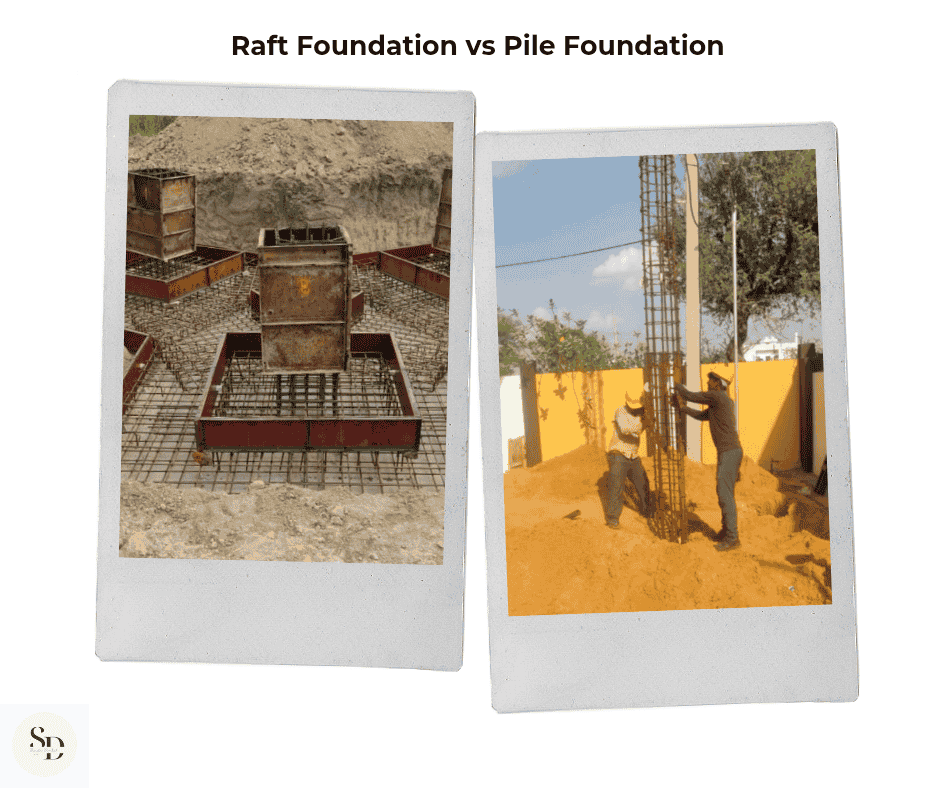
Ultimately, the choice between Raft and Pile foundations depends on a detailed assessment of site conditions, structural requirements, and budget constraints. Understanding the properties, applications, and limitations of each foundation type will enable engineers to make the best design choices for their projects.
Thank You Note
Thank you for taking the time to read this blog post on Raft Foundation vs Pile Foundation. We hope this detailed analysis has helped you understand the differences, advantages, and applications of both foundation types. If you have any further questions or need assistance with foundation design, feel free to reach out. Your feedback is always appreciated!
If you found this guide useful, feel free to share it with others in the construction industry. Stay tuned for more informative content on construction materials and testing methods.
Happy learning and building!
Frequently Asked Questions (FAQs)
What is a raft foundation?
What is a pile foundation?
When should a raft foundation be used?
What are the advantages of pile foundations?
What IS codes are relevant for pile foundation design?
What IS codes are relevant for raft foundation design?
What is the difference between a raft foundation and a pile foundation?
Note for Readers
If you’d like to read this blog in your regional language or any other international language, simply click on the Google Translator option located in the bar at the top of the page. This feature allows you to select your preferred language and enjoy the content in a way that’s comfortable for you. We hope this makes your reading experience more enjoyable and accessible!
Disclaimer
The information provided in this blog is intended for general informational purposes only. While every effort has been made to ensure the accuracy and reliability of the content, the author and publisher do not assume any responsibility for errors, omissions, or damages resulting from the use of this information. Always consult a professional engineer and refer to the relevant Indian Standard Codes (IS) and local regulations before making any design or construction decisions.
For more exciting topics, explore our other articles here
- Concrete Test: Field vs Lab
- Water Test: Field vs Lab
- Wall Pop vs Putty
- Soil Test: Field vs Lab
- Steel Test: Field vs Lab
- Concrete: DT vs NDT
- Brick Test: Field vs Lab
- Coarse Aggregate Test: Field vs. Lab
- Sand Test : Field vs Lab
- Cement Test : Field Vs Lab
- PCC vs RCC
- One-Way Slab vs. Two-Way Slab
- Brick Masonry vs Stone Masonry
- Difference Between OPC and PPC Cement